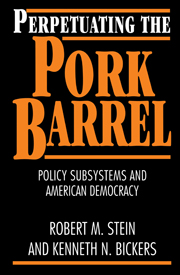Book contents
- Frontmatter
- Contents
- Tables and figures
- Acknowledgments
- PART I
- PART II
- PART III
- 4 A portfolio theory of policy subsystems
- 5 Policy subsystem adaptability and resilience in the Reagan period
- 6 PAC contributions and the distribution of domestic assistance programs
- 7 Congressional elections and the pork barrel
- PART IV
- APPENDIXES
- Notes
- Bibliography
- Index
5 - Policy subsystem adaptability and resilience in the Reagan period
Published online by Cambridge University Press: 05 June 2012
- Frontmatter
- Contents
- Tables and figures
- Acknowledgments
- PART I
- PART II
- PART III
- 4 A portfolio theory of policy subsystems
- 5 Policy subsystem adaptability and resilience in the Reagan period
- 6 PAC contributions and the distribution of domestic assistance programs
- 7 Congressional elections and the pork barrel
- PART IV
- APPENDIXES
- Notes
- Bibliography
- Index
Summary
In this chapter we turn our attention to the durability of policy subsystems. Specifically, we examine how subsystem actors respond to budgetary assaults on their program portfolios. In Chapter 4 we outlined the logic underlying our policy subsystem model. We found that policy subsystems operated in a predictable fashion, seeking a balance between maximum district coverage and minimum diversity of program recipients. Generally, however, we found that policy subsystems place a greater emphasis on minimizing the collective action problems of their interest group stakeholders than expanding district coverage, or program appropriations. We found that program appropriations were unrelated to either district coverage or recipient homogeneity. Our examination of subsystem strategies in Chapter 4 did not, however, differentiate between policy subsystems that were well supported and those under challenge. We might reasonably expect that the pursuit of subsystem strategies is made measurably easier when the fiscal and/or political climate is supportive rather than hostile.
The 1980s were a difficult decade for many policy subsystems at the federal level. During much of the decade, “politics as usual” was suspended, in part, as a consequence of the Reagan administration's active efforts to curtail spending in many areas of domestic policy. In part, it was a consequence of the fiscal constraint imposed by mounting budgetary deficits, a constraint expressed vividly in the Gramm–Rudman deficit reduction agreement. Taken together, these forces reached deep into the day-to-day functioning of many domestic policy subsystems.
- Type
- Chapter
- Information
- Perpetuating the Pork BarrelPolicy Subsystems and American Democracy, pp. 70 - 89Publisher: Cambridge University PressPrint publication year: 1995



